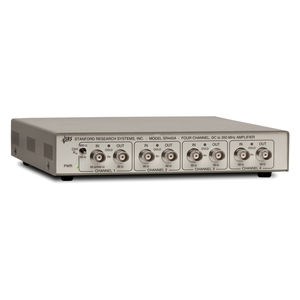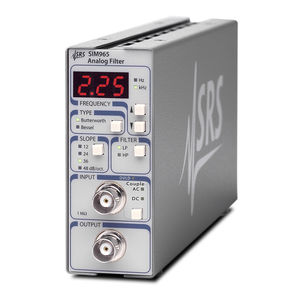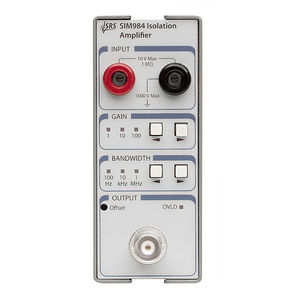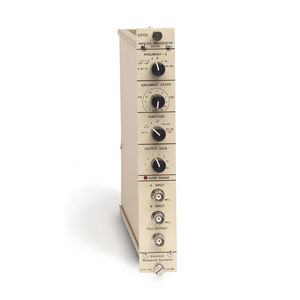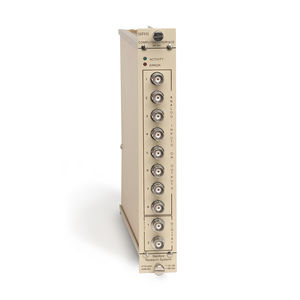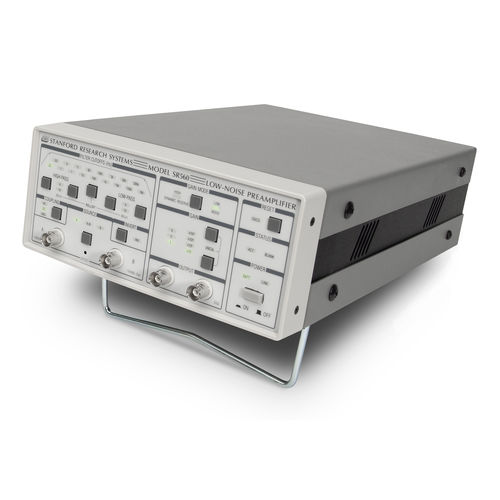
- Electricity - Electronics
- Electronic Component
- Voltage preamplifier
- Stanford Research Systems
Voltage preamplifier SR560differentialgainlow-noise
Add to favorites
Compare this product
Characteristics
- Type
- voltage
- Secondary function
- differential
- Other characteristics
- gain, low-noise, DC, benchtop
- Voltage
12 V, 100 V, 120 V, 220 V, 240 V
- Power
6 W, 30 W
- Frequency
Max.: 1,000,000 Hz
Min.: 0.3 Hz
Description
The SR560 is a high-performance, low-noise preamplifier that is ideal for a wide variety of applications including low-temperature measurements, optical detection, and audio engineering.
Inputs
The SR560 has a differential front end with 4 nV/√Hz input noise and an input impedance of 100 MΩ. Complete noise figure contours are shown in the graphs below. The SR560's inputs are fully floating (BNC shields are not connected to chassis ground). Both the amplifier ground and the chassis ground are available on the rear panel for flexibility in grounding the instrument. Input offset nulling is accomplished by a front-panel potentiometer, accessible with a small screwdriver.
In addition to the signal inputs, a rear-panel TTL blanking input lets you quickly turn off and on the instrument's gain. This is useful in preventing front-end overloading. The gain turns off 5 µs after the TTL level goes high, and back on again within 10 µs after the TTL signal goes low.
Outputs
Two insulated output BNC connectors provide 600 Ω and 50 Ω outputs. Both are capable of driving 10 Vpp into their respective loads. Two rear-panel power supply outputs provide up to 200 mA of ±12 VDC referenced to the amplifier ground. The outputs provide clean DC power for use as a bias source.
Gain
Gains are selectable from 1 to 50,000 in a 1-2-5 sequence. An adjustable gain feature lets you specify the gain as a percentage of any of the fixed gain settings with 0.5 % resolution. Gain can be selectively allocated before the filters to optimize noise performance, or after the filters to reduce susceptibility to overloads.
Catalogs
Other Stanford Research Systems products
Scientific Instruments
Related Searches
- Electronic filter
- Signal amplifying integrated circuit
- Passive electronic filter
- Low-pass electronic filter
- Crystal oscillator
- Electronic amplifying integrated circuit
- Electronic oscillator
- Instrumentation amplifier
- Voltage amplifying integrated circuit
- Analog amplifying integrated circuit
- High-pass electronic filter
- Adjustable amplifier
- Current amplifying integrated circuit
- Low-noise amplifying integrated circuit
- Benchtop amplifier
- Rack-mount amplifier
- Conditioning amplifier
- Frequency oscillator
- Signal preamplifier
- Differential amplifier
*Prices are pre-tax. They exclude delivery charges and customs duties and do not include additional charges for installation or activation options. Prices are indicative only and may vary by country, with changes to the cost of raw materials and exchange rates.















